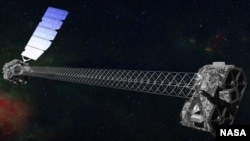The U.S. space agency is set to launch a telescope into space to seek out and study black holes, those still-mysterious celestial bodies that scientists believe lie at the heart of every massive galaxy, including our own Milky Way.
The new telescope, called NuSTAR but formally known as Nuclear Spectroscopic Telescope Array, could get airborne on June 13 from Kwajalein Atoll in the central Pacific.
Black holes have a gravitational pull so intense that not even light can escape from them. As gas, dust, and stars are sucked in, the material accelerates and heats up, generating powerful X-ray light emissions.
Stellar Census
Only a few decades ago, scientists thought black holes were rare. But their thinking has changed in the past 20 years, and now NASA is setting out to conduct a census of the black holes in the universe.
"Stars, nebulae, and black holes emit X-rays of the type that we use in medical X-rays, and these cannot be detected from the surface of the Earth," says Paul Hertz, director of NASA's astrophysics division. "But the NuSTAR telescope will focus these X-rays onto its digital camera and send the pictures back to Earth for scientific analysis."
Current telescopes provide images that show a general glow from hundreds of massive black holes. NASA expects NuSTAR will be able to provide far better images of black holes and other high-energy events when it surveys the extra-galactic sky.
The images will be studied by people around the world.
"NuSTAR will open a whole new window on the universe, by being the very first telescope to focus on high-energy X-rays," says NuSTAR's principal investigator, Fiona Harrison. "As such, it will make images that are 10 times crisper and 100 times more sensitive than any telescope that is operated in this region of the spectrum."
Eagerly Awaited
The NuSTAR telescope is about the size of a refrigerator, but it has a hidden tool. About a week after NuSTAR launches, it will deploy a 10-meter mast that will separate its mirrors from its detectors. That mast provides the distance required to focus the X-ray light into sharp images.
NASA scientists say that perhaps two out of every three black holes in the universe are hidden.
This telescope will be able to find these black holes behind their obscuring veils of dust and gas. It will also be able to tell how quickly a black hole is spinning, which will help scientists learn how black holes form.
"Like all of our NASA missions, we're going to find unexpected things out there that will lead us to questions and answers that we aren't even anticipating at this time," predicts Hertz.
NASA says NuSTAR will start providing data to scientists about a month after its launch.
The new telescope, called NuSTAR but formally known as Nuclear Spectroscopic Telescope Array, could get airborne on June 13 from Kwajalein Atoll in the central Pacific.
Black holes have a gravitational pull so intense that not even light can escape from them. As gas, dust, and stars are sucked in, the material accelerates and heats up, generating powerful X-ray light emissions.
Stellar Census
Only a few decades ago, scientists thought black holes were rare. But their thinking has changed in the past 20 years, and now NASA is setting out to conduct a census of the black holes in the universe.
"Stars, nebulae, and black holes emit X-rays of the type that we use in medical X-rays, and these cannot be detected from the surface of the Earth," says Paul Hertz, director of NASA's astrophysics division. "But the NuSTAR telescope will focus these X-rays onto its digital camera and send the pictures back to Earth for scientific analysis."
Current telescopes provide images that show a general glow from hundreds of massive black holes. NASA expects NuSTAR will be able to provide far better images of black holes and other high-energy events when it surveys the extra-galactic sky.
The images will be studied by people around the world.
"NuSTAR will open a whole new window on the universe, by being the very first telescope to focus on high-energy X-rays," says NuSTAR's principal investigator, Fiona Harrison. "As such, it will make images that are 10 times crisper and 100 times more sensitive than any telescope that is operated in this region of the spectrum."
Eagerly Awaited
The NuSTAR telescope is about the size of a refrigerator, but it has a hidden tool. About a week after NuSTAR launches, it will deploy a 10-meter mast that will separate its mirrors from its detectors. That mast provides the distance required to focus the X-ray light into sharp images.
NASA scientists say that perhaps two out of every three black holes in the universe are hidden.
This telescope will be able to find these black holes behind their obscuring veils of dust and gas. It will also be able to tell how quickly a black hole is spinning, which will help scientists learn how black holes form.
"Like all of our NASA missions, we're going to find unexpected things out there that will lead us to questions and answers that we aren't even anticipating at this time," predicts Hertz.
NASA says NuSTAR will start providing data to scientists about a month after its launch.











